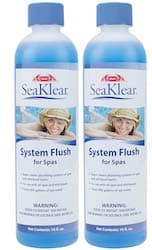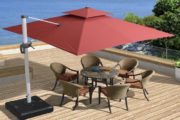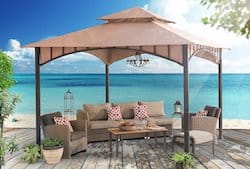This independent website is funded by its readers. It can earn a commission on any purchases made through product links, at no extra cost to the buyer. Learn more >
If you are lucky enough to live in an area with a year round ambient temperature that doesn’t fall below 40º F you should be able to continue to enjoy your hot tub in the open air year round without worrying about having to bring it inside.
Most of us can enjoy our hot tubs though to late fall. Climbing into a steaming hot tub on a crispy Autumn evening is just a brilliant way to end your day, but when the temperature fall too far it’s time to winterize our hot tub.
Like most good things it comes to an end and at some point the tub has to be brought inside.
Many portable hot tub owners that have the space simply relocate the tub inside and continue to enjoy the benefits through the colder months. The portability of hot tubs as well as their reasonable price tag are just two of the many compelling reasons for buying an inflatable hot tub in the first place.
If your portable hot tub is going into storage then these simple to follow steps should help you through the winterize hot tub process.
Flush The Hot Tub Plumbing
Before putting our inflatable hot tub away for its winter hibernation we need to make sure it’s clean in places we can’t easily get to and don’t even see.
The internal plumbing should be flushed regularly on water changes and laying down your tub is no different. We are having a a water change, it’s just it might take four or five months between emptying and filling.
Unpleasant biofilms can build up in the hot tub plumbing so best taken care of before deflation and storage.
It’s definitely worth the time, and minimal expense, it will help insure you don’t have a cloudy hot tub on startup next season
We recommend…

SeaKlear Spa Hot Tub System Flush
on Amazon.com
Disconnecting The Hot Tub
Before starting our tear down obviously the tub is turned off and the plug has been removed from the power outlet.
Before we can disconnect the hoses that run from the pump to the tub we must insert the plugs inside the tub (these are the plugs that were fitted inside the tub prior to its original build)
OK now it is safe to disconnect the hoses without the risk of an uncontrolled release of water.
Now the filter MUST be removed, forgetting and leaving it in has a high potential to cause serious damage to your inflatable.
Flush through through the filter pump with clean fresh water and it’s a good idea to dry it as much as you can with some kind of absorbent material.
That’s phase one complete, pretty painless so far.
Draining Your Hot Tub
Now we are ready to drain the tub. Attach you garden hose to the drain valve connector that came with your tub and then connect to the drain outlet on the tub.
Now you can remove the interior plug and open valve on the connector and your tub will start to drain.
But wait. Make sure the water is releasing into a suitable drain. Remember that this water has been chemically treated. Although the chemicals in the water are mild enough for us to bath in it can kill flowers, and will almost certainly discolour most types of grasses. Buy or borrow a hose extension if necessary to get the water safely drained.
Cleaning The Hot Tub
Before deflating is a good time to give the inside of the tub a thorough clean. Because it is still inflated we can’t reach all the crevices inside the tub, but we will get to most of them. We can deal with whats not reachable when the tub is deflated.
Although the tub water had been chemically treated, after a summer season of use there will still be a build up of oils and debris inside.
Thoroughly clean the inside just using a mild detergent or washing up liquid mixed in with some warm water. Dry with an absorbent cloth.
Many tubs have handles fitted on the side so with an assistant the tub can be turned over to reveal the base. This will also help to drain any water that is still left in the tub.
The base often needs the most attention because it hasn’t seen the light of day for a season. It will need special care to clean it. If it proves especially difficult to clean then wait until the tub has been deflated so more pressure can be applied to aid the cleaning process.
Deflating Your Hot Tub
Take care to keep to keep all the components together when doing this final dismantle. A missing coupling or valve will be a disappointing hassle come next Spring.
With the tub deflated check and clean the areas around the base perimeter. Work around the perimeter where it meets the base. Take particular care to dry this area as you go. If they are left damp they will attract a build up of mould and mildew which is what we want to avoid.
The base exterior can be worked on at this point too if it still needs attention.
After a final check for damp and prior to final folding it is a good idea to sprinkle and rub in a non perfumed talcum powder. This should stop the liner sticking together over the winter storage.
Final Storage Place
Some tubs come with a carrying case, if the liner can be got back into that then great. Often times either they don’t have a carrying case but still they are best stored in some kind of tarpaulin. Try to make the tarp as “airtight” as possible without damaging the liner. Don’t store on the floor.
Vermin !!
It might seem an odd thing to have to consider, but anybody that has had electrical wiring gnawed through in their home knows that rats and mice are particularly fond of PVC and Teflon. So a large bundle of PVC like an inflatable hot tub carcass would look like an enormous tasty lunch and diner for our unwanted furry guest and his family. Just a single rodent can cause irreparable damage to your tub, a family!!. Yikes!!!
Keep this in mind when choosing your tubs winter storage.
You can find inexpensive plug in ultra-sound vermin repellers can be particularly effective in small enclosed areas. The best storage of course is somewhere inaccessible to rats and mice. Easier said than done in some areas.







